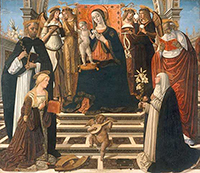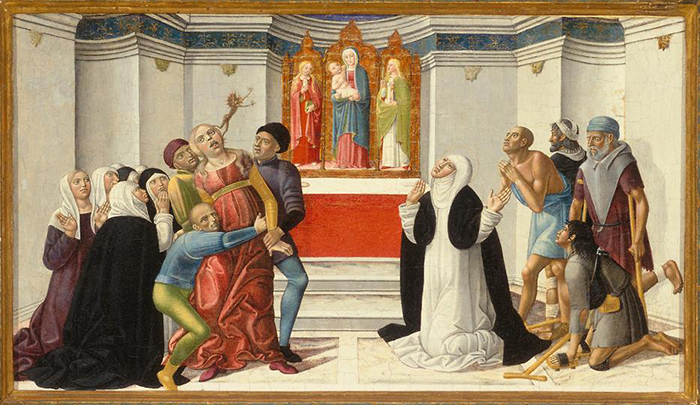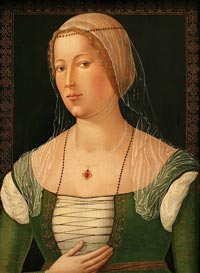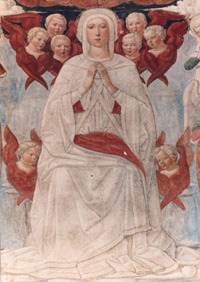Girolamo di Benvenuto and Benvenuto di Giovanni |
The son of Benvenuto di Giovanni, Girolamo was born in Siena in 1470 and died there in 1524. He trained with his more successful father and collaborated with him on many projects. His first known independent work, the Assumption of the Virgin of 1498 (Museo Civico, Montalcino), displays the elongated columnar figures with devoutly placid expressions which are characteristic of his style. Firmly rooted in the Sienese tradition, Girolamo was a contemporary of Pacchiarotto, Girolamo Genga, Fungai, and Pinturicchio, with whose works he must have been familiar. His secular work is particularly important, especially his birth trays (Hercules at the Crossroad, Galleria Franchetti, Ca' d'Oro, Venice). |
This portrait, one of Girolamo's finest paintings, is among the few in which his individual style can be distinguished. While in his father's workshop, Girolamo — like other assistants — would have suppressed his own style in favor of the master's.
|
||
| The chapel of the Saints Fabiano and Sebastiano is a sacred building situated in the resort Camparboli near Asciano. It is the most imposing road-tabernacle of the whole territory of Asciano and it still shows, in the front, the traces of a plugged arch, which is a sign of the original function of public oratory, underlined also by the presence, under the Assumption of the Virgin Mary, a fresco painted by Girolamo di Benvenuto, of Saint Fabiano and Saint Sebastiano, who are the protectors against the plague and the epidemics, and the three saints, S. Girolamo, S.Rocco and S. Lucia, painted inside false aediculas, maybe by the young Girolamo del Pacchia, on the wall on the right of the high altar. Girolamo di Benvenuto was a pupil and longtime collaborator of his father, Benvenuto di Giovanni. He asserted himself as an independent painter on 1498, completing the Assumption now on display in the museum at Montalcino. His secular work is particularly important, especially his birth trays (Hercules at the Crossroad, Galleria Franchetti, Ca' d'Oro, Venice). His father, Benvenuto di Giovanni di Meo del Guasta was the son of a bricklayer and lived and worked in or near Siena all his life. He is first recorded working as an artist in 1453 when he was painting in the Siena Baptistery, probably with il Vecchietta, who may have been his teacher. In his early years he was also influenced by Matteo di Giovanni, Francesco di Giorgio and Neroccio de' Landi. His style changed considerably in the 1480s. In a tax return of 1465, Benvenuto declared himself to be without property or relations and to be living near the baptistery. The following year he married Jacopa di Tommaso da Cetona with whom he had seven children. They owned a vineyard, and Benvenuto served at least two terms in public office. Among his extant works, nine are signed and dated altarpieces, four are identifiable through documents and many others can be attributed to him on stylistic grounds. Their dates span 43 years, and they include panel paintings, frescoes, manuscripts and designs for the decorative pavement of Siena Cathedral. |
||
| Girolamo di Benvenuto (1470–1525), Madonna della neve, 1508, Pinacoteca Nazionale di Siena |  |
|
|



